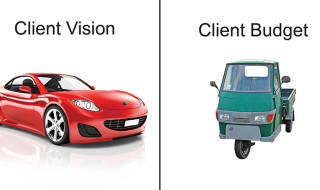 Cathy Johnson gives us ten top tips on how to get the best from your designer
Cathy Johnson gives us ten top tips on how to get the best from your designer
Controversial I know, but the fact is that most dentists – including many I count as close friends – appear to have a penchant for control. It is, after all, an essential character trait for anyone in a precision-orientated profession.
When a dentist and designer come together, however, tussles at the control tower can prevent the designer from doing his or her best work. You know only too well how it feels when patients self-diagnose, or a so-called family ‘expert’ has a fixed idea about treatment.
In any professional relationship, communication is key, with expectations and boundaries established at the outset. The following 10 tips offer a guide to the creative process — how to prepare, what to expect — to help pave the way for a mutually rewarding experience.
1. Plan ahead
Branding and marketing should not be left until the last minute, so build in time to plan. For the dentist, steady preparation will generate a sense of control over timescale and budget, which will set the pace for the entire process. For the designer, creative ideas flow with ease into a quiet mind, so the optimum results will manifest more readily within a realistic timeframe.
2. Choose the right person
Appointing the right designer is an important decision and recommendation is a great place to start. A positive referral should guide you to someone professional, efficient and reliable, although what works for one person may not always suit another. You need a trained graphic designer with plenty of experience in the dental world. Of course view portfolios and check out testimonials, but remember that rapport is essential for a lasting relationship. Whether face-to-face or over the phone, speak directly with the designer who will carry out the creative work to ensure the chemistry is right.
3. Establish your budget
When tip 1 is overlooked, dentists frequently sink all available funds into the surgery itself. Furthest from their minds, and from the financial spreadsheet, is adequate provision for the marketing budget. Patients are not drawn to a practice because of its state-of-the-art chair and über-gizmos — only dentists get off on that kind of stuff! Patients judge a practice by other means and first impressions make all the difference — be it via stylish signage, a stunning website, impressive literature, or savvy social media. It’s vital to get noticed for all the right reasons and at every opportunity, which is where consistent branding makes its mark. Align your vision with your budget, make realistic provision for design fees and production costs and view it as an investment. You charge for the work you do based on your skill and experience, and the same applies to designers, so don’t be tempted to cut corners — pay peanuts and a monkey may well show up.
4. Provide a clear brief
Every practice is different and designers are not telepathic, so communicate everything you can about your vision at the outset. ‘I’ll know what I like when I see it’ is simply not enough for a designer to go on. Explain every detail, including the ethos of your practice and your immediate and long-term goals. Describe the range of services you provide, the patients you want to attract and who your competitors are. Discuss your colour preferences and show examples of branding you like. Do you prefer soft flowing images or geometric shapes? Are you after something traditional or a more contemporary style; muted tones or a vibrant, bold approach? The mental pictures your designer makes at the briefing stage will be developed, expanded upon and crafted into the final presentation, so the more you share the better.
5. Delegate
There’s a great phrase used in coaching: ‘Successful people have successful habits’ and one such habit is the art of delegation. Successful people select their preferred suppliers, establish trust and then delegate, fully, which frees everyone up to focus on their own skillset. The dentist and designer are no exception and, if you follow tips 1–4, you can get down to dentistry and leave the designer to get creative. The best results will always be achieved when the dentist does something completely alien and relinquishes the reins.
6. Be patient
Designing your brand image will not simply happen overnight; it will take some time and effort. By following tip 1, you already have control of the timeline and, using tip 4, a clear brief will eliminate the need to interfere or, worse still, change course completely mid-way through. There’s more to this arty lark than nick, cut and paste and, if you want something original, your designer will require time to explore and evolve a range of concepts without undue pressure. Stick with tip 5 and all will be well.
7. Don’t obsess about colour
The way colours are viewed, both in print and on screen, will often vary widely. Even Pantone inks, the industry standard, look different depending on the type of paper onto which they are printed and whether it is coated or uncoated. Then there’s four colour printing, known as CMYK, in which halftone images are made from tiny dots representing percentages of only four inks (cyan, magenta, yellow and black). It’s a fine-tuned process and slight variations must be allowed for. Similarly, pdfs are notoriously unpredictable for colour matching and, as the RGB (red, green and blue) colour model used on computer screens is device-dependent, colours inevitably look different from screen to screen. For dentists, used to working in precise shades of white, this can be something of a minefield, so it’s important not to fixate over colour and to trust your designer’s judgment.
8. Let experts handle print
There’s a learned interaction between the dentist and technician and the same goes for the designer and printer. Designers use specialist graphics programmes to provide printers with exactly the right file format, for litho or digital, as is required. They specify the type and weight of stock and liaise on such matters as ‘work and turn’, ‘sheet work’ or ‘work and tumble’ (sounds fun!) along with binding and specialist finishing techniques. Dentists who focus on cheap deals, on the assumption that one size fits all, risk a botched job and often end up throwing good money after bad. Akin to a patient choosing the lab, quality and accountability can soon go awry. Leave print and production to the experts – it’s tip 5 all the way.
9. Never abdicate
There’s a big difference between delegation and abdication. Delegate responsibility to your designer, but remain available for your part in the collaboration. This means responding to emails that request your feedback/approval, ensuring you provide high res images (largest size possible) and thoroughly proofed text, on time and in the requested format. Your designer will aim to meet your deadline but, for them to do so, you must be available when required. Similarly, designers are much more likely to pull out all the stops when they are respected, which includes paying their invoices on time.
10. Sit back and relax
Now that you’ve chosen your designer, agreed the cost, given a comprehensive brief and handed over the reins, there is no need to control anything. Surprisingly, this may even feel good! Your wishes will be respected and you will be consulted when necessary, so rest assured that your designer is doing their absolute best for you. It’s time to relax and look forward to being thrilled with the result.
Cathy Johnson specialises in branding for dental practices. Her success is built on more than 25 years of experience as a graphic designer combined with in-depth understanding of the needs of the dental profession. She and her team are based in London and work with practices across the UK and internationally. Working with single practitioners through to large dental groups, all services are tailor-made to suit each individual practice.
Cathy Johnson Design Tel: 020 7289 1215
[email protected]
www.cathyjohnsondesign.com



